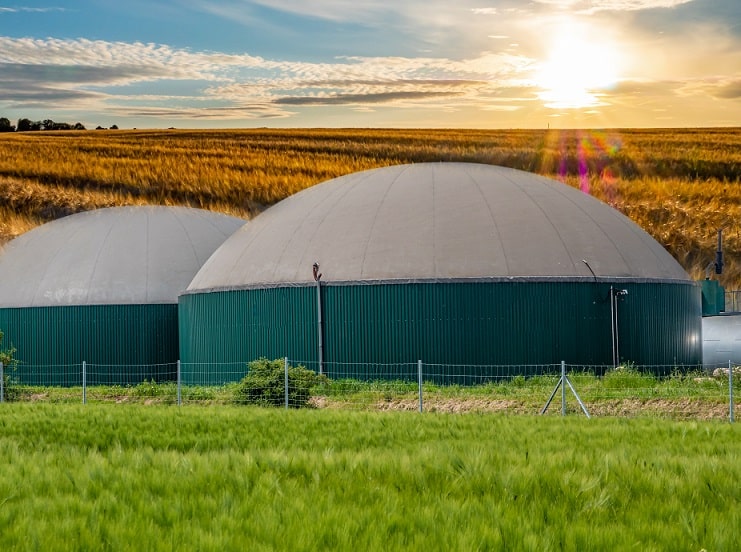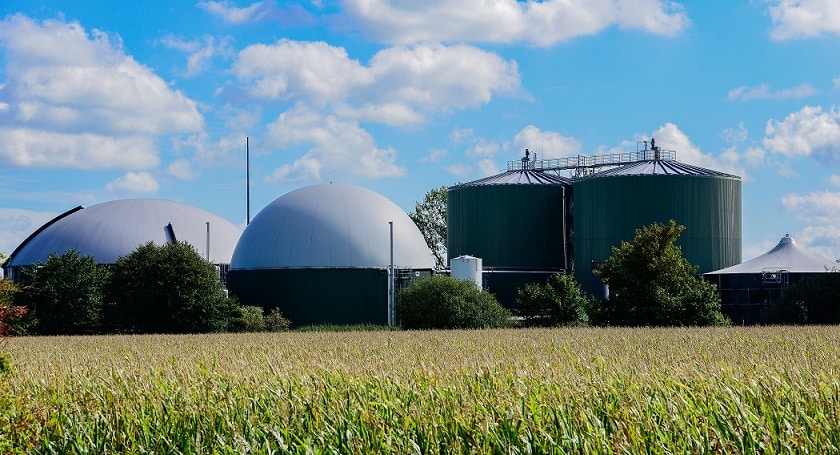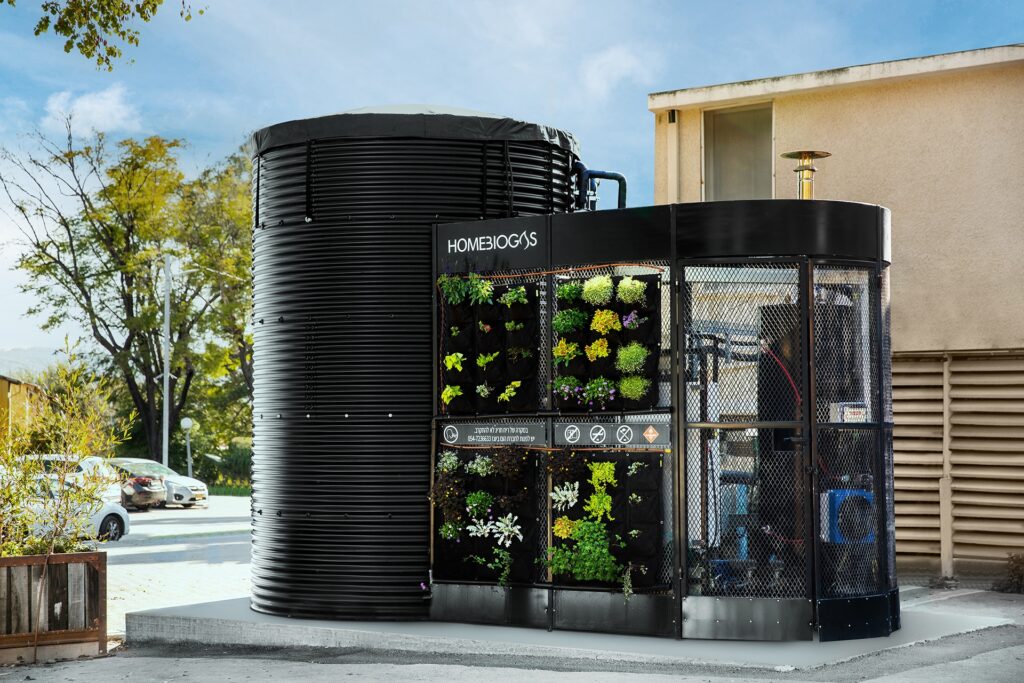
Commercial Biogas Explained
Commercial biogas refers to the industrial production of biogas — the process of transforming organic matter into a source of energy through anaerobic digestion at scale.
Commercial biogas facilities produce energy resources, such as electricity, heat, and biomethane, to meet internal energy requirements. Moreover, the organic matter used to generate biogas comes from livestock manure, agricultural residue, and municipal and industrial waste. This way, these facilities provide clean energy while elevating waste management with a lower environmental impact.
Commercial biogas plants involve high installation costs and produce more expensive electricity than alternatives like photovoltaic, wind power, or fossil fuels. However, studies show that long-term stable and efficient biogas production is possible with optimized system configuration and technical breakthroughs.
How Can Biogas Be Produced Commercially?
The biogas production process is a relatively simple, carbon-neutral process. It mimics natural anaerobic digestion in an artificial setting to capture the gas and store it for various purposes. As a general rule, most facilities producing biogas employ similar techniques.
Anaerobic digestion consists of four biological processes through which microorganisms break down plant and animal matter in sealed containers to produce biogas, a mixture of methane, carbon dioxide, and other gases.
Here’s a simplified breakdown of the process:
- Hydrolysis converts the biomass in the digester into sugars, amino acids, and fatty acids.
- Acidogenesis ferments these into volatile fatty acids and alcohols.
- Fatty acids and alcohols are converted into hydrogen, carbon dioxide, and ammonia.
- Methanogens convert hydrogen and acetic acid into biogas.
Besides biogas, the process also produces an organic material called digestate, a rich source of organic matter and nutrients like potassium, nitrogen, and phosphorus — essential components of nutrient-rich compost and fertilizer.
Stages of Biogas Production
- Pre-treatment
A commercial biogas facility has a reception area where the feedstock from various sources arrives and is then directed toward the pre-treatment stage. Depending on the type of waste and its provenience, the pre-treatments can include washing, macerating, screening, and pressing. Non-biodegradable packaging, metal, grit, and other substances that could slow down the decomposition process get discarded.
The pre-treatment usually occurs in mixing pits equipped with propellers to mix, cut the feedstock if necessary, and pump it into the digester. Depending on the system’s complexity, the organic matter could also be pre-heated here to prevent a temperature shock inside the digester.
- Decomposition
Once the pre-treatment procedure is completed, the feedstock is delivered into the digester. This massive, sealed chamber provides an oxygen-free environment where bacteria can start the decomposition process.
The digesters are usually made of steel or concrete and have a longish channel shape to maximize biomass flow. Large digesters are frequently stirred by gradually spinning paddles or rotors.
Biogas is released during decomposition and collected in an inflated dome or biogas storage tanks. Pumps transport the biogas to a desulphurization station to lower the sulfur level in its composition.
The organic waste resulting from the digestion gets removed from the digester. It may subsequently go through pasteurization, composting, or separation of wet and dry solids before being applied to agricultural land.
- Biogas treatment
In general, biogas plants for industrial use treat the biogas using physicochemical techniques — with scrubbing utilized often for removing hydrogen sulfide and carbon dioxide. Small- and medium-sized anaerobic plants that treat municipal wastewater can also use dilution (venting) as a disposal technique.

How to Choose a Commercial Biogas System
Here are some key elements that every commercial biogas plant must successfully incorporate to function efficiently:
- Supervisory control and data acquisition equipment. The anaerobic digestion system needs to have precise dosing settings and be able to adjust the feedstock and micronutrient doses for continuous operating efficiency. Moreover, an interlocked alarm device is necessary to control the biomass input and stop the feeding in the case of a gas pressure alert.
- Low energy consumption. The costs associated with building and maintaining a large-scale biogas plant are generally high, so choosing a system with low energy consumption is a way to keep long-term costs under control and reduce the plant’s dependence on its electricity production.
- Flexibility. The layout of a biogas plant must be adaptable so you can easily accommodate various types of feedstock as necessary.
- Data accessibility. An effective biogas plant maintains stable digester conditions during biogas generation. For this to happen, you need a system that continuously monitors and records data. Additionally, you need quick access to data anytime to guarantee efficient operation.
- Constant temperature. Maximizing the potential for creating biogas in an environment where microorganisms can thrive and accelerate the decomposition process is necessary.
- Safety systems. A commercial biogas plant must have effective safety systems, compliant with local laws, and, if applicable, any industry standards.
Types of Commercial Biogas Plants
Batch-Type Biogas Plant
The digester is fully loaded, sealed, and given enough time to complete the decomposition process in a batch-type biogas plant. It’s an effective method when getting the daily supply of feedstock is challenging.
When the digestion is finished, the residue is drained, and the digester refilled.
The downside is that gas generation is uneven because bacterial digestion progresses slowly at first, peaks, and then slows down with increasing consumption of volatile materials.
Continuous Type Biogas Plant
The digester is regularly fed with biomass in a continuous type biogas plant. Depending on the complexity and size of the system, these plants can be:
Single-stage — the digestion of waste materials occurs in a single chamber.
Double-stage — the acidogenic and methanogenic stages occur in two distinct chambers.
Double-stage biogas plants are usually more productive than single-stage, most suitable for large, more complex facilities.
Movable Type Drum Plant (Floating Dome Type)
In a movable drum type, the digester has an intake on one side for slurry feeding and an outlet for digested slurry removal. The gas gathers in a steel gasholder inverted over the slurry. This container moves up and down under the guidance of a central guide pipe to maintain constant pressure.
The gas holder must be treated with anticorrosive paint annually.
Global Commercial Biogas Production in Numbers
- The global biogas market is expected to register a more than 4.5% CAGR from 2022 to 2027.
- The global commercial biogas market revenue was $4.3 billion in 2020 and can reach $6.5 billion by 2026. The Asia Pacific is most likely to dominate the global market.
- In 2015, China had 110,448 biogas systems, of which 6,972 were large-scale.
- The commercial biogas plants market in the US was estimated at$468.8 million in 2021.
- As much as 75% of Europe’s total industrial biogas production is used for electricity production.
- In 2021, the European biogas plant market was estimated at $1.87 billion. The European industrial production of biogas is expected to increase the market’s value to $3.47 billion by 2028.
- In 2020, Europe had 18,855 biogas plants and 726 biomethane plants.
- Scaling up the production of renewable gases in Europe could generate between 600,000 and 850,000 direct jobs and close to 1.5 million indirect jobs by 2050.
- In comparison to an energy system that uses only a little amount of gas, the usage of renewable methane and hydrogen can save about $221 billion a year.
Future of Commercial Biogas Production
Biogas plants for industrial purposes have many potential applications, as biogas can be easily transformed into heat and power — which explains the predictions above around the possible expansion of the global biogas market. Given the many benefits of biogas, venture capital investments in biogas plants are also on the rise.
Moreover, environmental and governmental policies and regulations worldwide support biogas, particularly in the US and Europe. In general, interest in biofuels is growing, and more companies are investing in biogas facilities to support and, at the same time, benefit from the decentralized production of renewable energy from organic waste.
As more scale-up and commercialization opportunities are analyzed and new projects get implemented, we can expect the market to become even more appealing to investors and innovators.
HomeBiogas Commercial System
The HomeBiogas Commercial System can process up to one ton of organic waste daily on-site. It’s a revolutionary on-site organic waste treatment solution that converts organic matter into renewable energy that can be used to heat water while also producing organic fertilizer for gardens.
The HomeBiogas Commercial System is a comprehensive option that manages organic kitchen waste, is user-friendly, and integrates with the existing kitchen layout to provide hot water. The cutting-edge technical elements work with a specialized remote control and app and integrate IoT and cloud-based technology.
The system occupies a concrete surface of up to 8×6.2 square meters and can generate up to 576 kWh of heat energy per day — enough to heat 9600 liters of water at 50° Celsius. The biogas plant can be placed close to facilities catering to big crowds of people to handle organic waste effectively and minimize waste management costs.

Conclusions
The development of biogas plants for industrial use has accelerated significantly during the past years, and the interest in building large-scale facilities has grown. That’s because producing biogas from organic waste can help fix two problems with one straightforward solution. Biogas production not only facilitates waste management with reasonable costs but also generates renewable energy that can be easily treated to substitute natural gas, positively impacting local economies and the environment.






